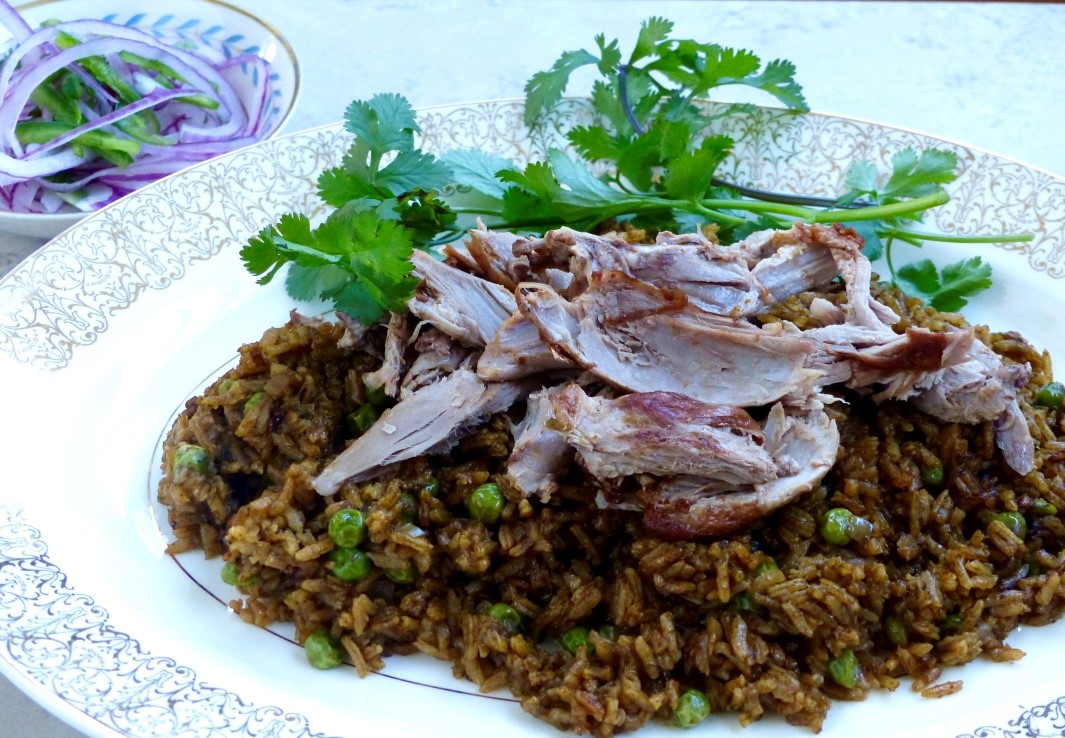
Serves 6 to 8
Ingredients
The combination of rice and duck is an esteemed dish that is popular all over northern Peru. Muscovy duck was domesticated there by the pre-Inca civilizations. It benefits from long slow cooking. The rice is perfumed by a combination of cilantro and spinach leaves pureed into the stock used to cook the rice. Make sure your rice is well seasoned and tasty, as it really is the most important element of this dish, the duck is simply a flavoring for the rice.
Dried panca peppers are used in this dish, but guajillo peppers are more easily found and make a good substitute – that’s what I used. They are found in many grocery stores and Latin markets, but you can use any dried pepper that you can get your hands on. If you can find a jar of aji amarillo paste that works too, add about half cup to your braising liquid. And if that all fails, try using a tablespoon or two of chili powder in the dish to give it some kick.
Ingredients
4 duck legs, about 2 lb. (or substitute 4 chicken legs)
3 dried panca peppers or guajillo peppers
1 tbsp. red wine vinegar
6 large garlic cloves, finely chopped
1 red onion, finely chopped, about 1 heaping cup
1 green or red bell pepper, finely chopped, about 1 heaping cup
1 tsp. ground cumin
1 tsp. freshly ground black pepper
2 tsp. kosher salt
1 bottle dark beer
2 handfuls baby spinach
1 cup cilantro leaves
2 cups long-grain white rice
1 cup frozen peas
Directions
Heat a soup pot over medium heat. Prick the duck pieces all over with a fork, and place skin side down in the hot pot. Brown on both sides, about 10 minutes, turning occasionally, until the fat is starting to render. Remove the duck pieces to a plate, pour off the excess fat and reserve. Leave 2 tablespoons in the pot to continue with the recipe.
While the duck is browning, stem and seed the dried peppers, place in a small saucepan with 2 cups of water and bring to a simmer. Cook the peppers until soft, about 15 minutes. Put the peppers, the red wine vinegar, and enough of the liquid into a blender so that it will blend properly, and puree until smooth. Set blender container aside for now.
Add the garlic to the soup pot and sauté for 30 seconds. Next, add the onions and cook for one minute, followed by the green peppers for one minute. Add the cumin, salt and pepper, stir for one minute.
Pour the dark beer and the chile stock into the soup pot. Add 3w cups of water to the blender jar to clean out any chile residue, add to the pot. (Hang on to the blender jar. You’ll use it again.) Place the duck legs into the broth. Bring to a simmer, uncovered, and cook until the duck is tender, about 45 minutes to an hour. Remove the duck from the pot to a plate again. Hopefully the liquid will have reduced to about 4 cups, but if not reduce the broth until it has.
(You can make the dish one day ahead to this point. Shred the duck meat, and store the broth separately. The next day, heat up the broth and continue with the recipe.)
Grab your blender again. Add the spinach, cilantro, and a ladleful of the hot duck broth. Blend and pour back into the pot.
Rinse the rice and let drain until dry, or pat dry with paper towels. Heat up a large sauté pan and add two tablespoons of the reserved duck fat. Add the rice and stir to coat with the fat. Let the rice cook for a few minutes until the grains look dry and a little toasty. Add the rice to the hot broth.
Bring to a low boil, (do not cover) and simmer until most of the liquid has been absorbed, about 10 minutes. Reduce heat to low, add the frozen peas to the top of the rice, cover the pot, and finish cooking for another 10 minutes. Turn the heat off, remove the lid, fluff the rice with a fork, cover with a lid for 10 more minutes.
While the rice is finishing, shred the meat from the duck legs.
To serve, turn the rice out onto a large platter, and add the shredded duck meat on top. Garnish with more cilantro. Serve with Salsa Criolla.
Country:
Peru
Notes and Instructions
Recipe credit: Linda McElroy, adapted from Gran Cocina Latina, by Maricel Presilla
Photo credit: Linda McElroy
